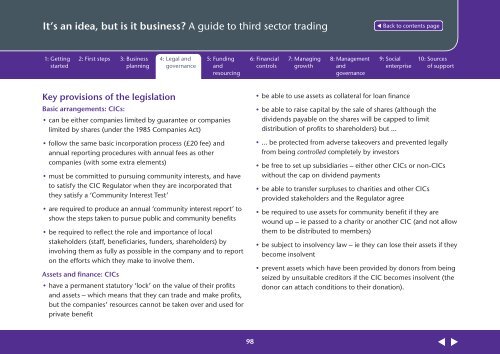A guide to third sector trading - WCVA
A guide to third sector trading - WCVA
A guide to third sector trading - WCVA
Create successful ePaper yourself
Turn your PDF publications into a flip-book with our unique Google optimized e-Paper software.
It’s an idea, but is it business? A <strong>guide</strong> <strong>to</strong> <strong>third</strong> sec<strong>to</strong>r <strong>trading</strong><br />
1: Getting<br />
started<br />
2: First steps 3: Business<br />
planning<br />
4: Legal and<br />
governance<br />
5: Funding<br />
and<br />
resourcing<br />
6: Financial<br />
controls<br />
7: Managing<br />
growth<br />
8: Management<br />
and<br />
governance<br />
9: Social<br />
enterprise<br />
10: Sources<br />
of support<br />
Key provisions of the legislation<br />
Basic arrangements: CICs:<br />
• can be either companies limited by guarantee or companies<br />
limited by shares (under the 1985 Companies Act)<br />
• follow the same basic incorporation process (£20 fee) and<br />
annual reporting procedures with annual fees as other<br />
companies (with some extra elements)<br />
• must be committed <strong>to</strong> pursuing community interests, and have<br />
<strong>to</strong> satisfy the CIC Regula<strong>to</strong>r when they are incorporated that<br />
they satisfy a ‘Community Interest Test’<br />
• are required <strong>to</strong> produce an annual ‘community interest report’ <strong>to</strong><br />
show the steps taken <strong>to</strong> pursue public and community benefits<br />
• be required <strong>to</strong> reflect the role and importance of local<br />
stakeholders (staff, beneficiaries, funders, shareholders) by<br />
involving them as fully as possible in the company and <strong>to</strong> report<br />
on the efforts which they make <strong>to</strong> involve them.<br />
Assets and finance: CICs<br />
• have a permanent statu<strong>to</strong>ry ‘lock’ on the value of their profits<br />
and assets – which means that they can trade and make profits,<br />
but the companies’ resources cannot be taken over and used for<br />
private benefit<br />
• be able <strong>to</strong> use assets as collateral for loan finance<br />
• be able <strong>to</strong> raise capital by the sale of shares (although the<br />
dividends payable on the shares will be capped <strong>to</strong> limit<br />
distribution of profits <strong>to</strong> shareholders) but …<br />
• … be protected from adverse takeovers and prevented legally<br />
from being controlled completely by inves<strong>to</strong>rs<br />
• be free <strong>to</strong> set up subsidiaries – either other CICs or non-CICs<br />
without the cap on dividend payments<br />
• be able <strong>to</strong> transfer surpluses <strong>to</strong> charities and other CICs<br />
provided stakeholders and the Regula<strong>to</strong>r agree<br />
• be required <strong>to</strong> use assets for community benefit if they are<br />
wound up – ie passed <strong>to</strong> a charity or another CIC (and not allow<br />
them <strong>to</strong> be distributed <strong>to</strong> members)<br />
• be subject <strong>to</strong> insolvency law – ie they can lose their assets if they<br />
become insolvent<br />
• prevent assets which have been provided by donors from being<br />
seized by unsuitable credi<strong>to</strong>rs if the CIC becomes insolvent (the<br />
donor can attach conditions <strong>to</strong> their donation).<br />
98












